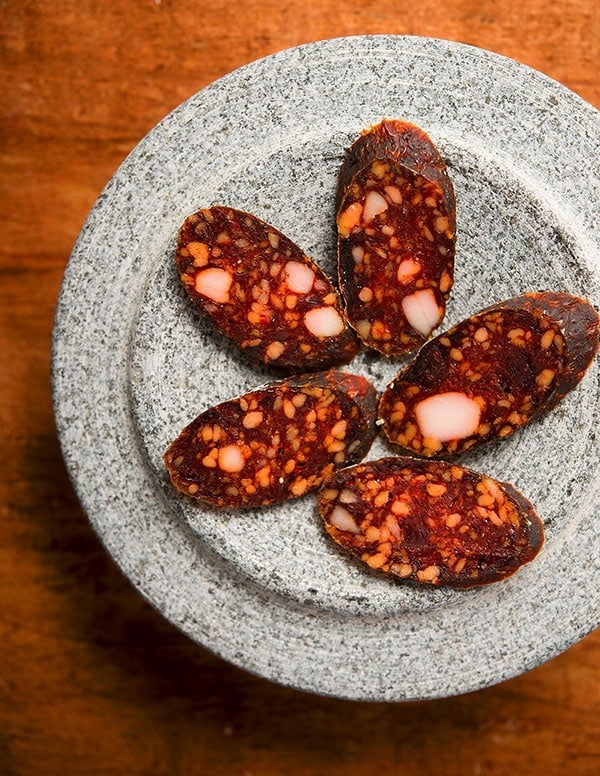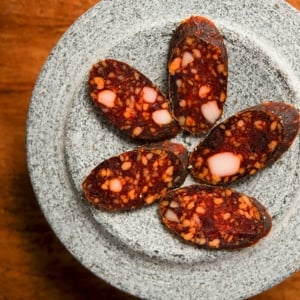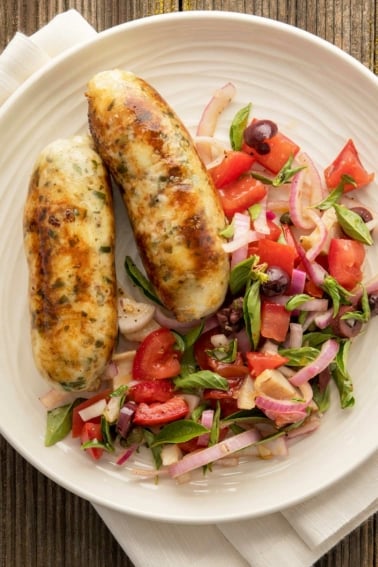As an Amazon Associate I earn from qualifying purchases.

I’d be lying if I told you that this was some secret, authentic Hungarian salami recipe. It ain’t. But if you like those smoky dried Magyar salamis you can get at places like Cleveland’s West Side market or on the Upper East Side of Manhattan, this is for you.
I’ve eaten a lot of these sausages over the years, and they all share a few things in common: Garlic, smoke and lots and lots of real Hungarian paprika. Some are spicy, some mild, some tangy, some so fatty they feel creamy when you eat them. The best examples from Hungary to my mind are the salamis from Bende and Pick, and this recipe is more or less shooting for that.
When I say real Hungarian paprika, I mean it. There is a difference in flavor between the admittedly good California paprika and the Magyar stuff. This recipe uses both sweet and hot paprika, and quite a bit of it, so you might as well get the good stuff. Oh, and this is most definitely not Spanish smoked paprika, which, while awesome, makes a Spanish sausage, not a Hungarian one.
This is a salami recipe, not a recipe for a fresh sausage. That bears repeating. It’s not for beginners. If you are not an experienced maker of fresh sausages, I don’t recommend that you make this. It is a technical deal, and considering that this is uncooked, fermented meat, you don’t want to mess around.
You will need a few things before you even start:
- The obvious: Meat grinder, sausage stuffer, casings, kitchen scale etc.
- Instacure No. 2 and a bacterial starter culture.
- A humidifier, or a place where the humidity at least 85 percent.
- A place to hang your sausages in a cool, humid environment that is around 75 percent humidity and about 55°F.
- A smoker. This is a smoked salami.
- Another useful tool is a laser thermometer, which lets you take something’s temperature instantly. I use a BAFX Products thermometer and I like it a lot.
The basic method for this salami is to make your fresh sausages, ferment them, smoke them and then hang in a cool, moist place until they’re ready. Ready means the links have lost about 30 percent of initial weight. I no longer weigh my salami this precisely, but it’s a good idea to do so until you get “the eye.”
What will you get when you are done? A rich, intensely flavorful dried Hungarian salami that is “meat forward,” meaning that the flavor of the meat and fat are the main stars — so use good meat — with the flavors of the paprika and garlic playing backup. I eat this salami as part of a charcuterie plate, but also as road food (screw you, McDonalds!) or as a snack whenever I am hunting or fishing.
Hungarian Paprika Salami
Ingredients
- 3 1/2 pounds pork, , duck, venison, etc
- 1 1/2 pounds pork belly or fatty pork shoulder
- 51 grams (about 3 tablespoons) kosher salt
- 1 tablespoon sugar or dextrose
- 6 grams (about a teaspoon) Instacure No. 2
- 6 garlic cloves, minced
- 4 tablespoons Hungarian sweet paprika
- 1 tablespoon Hungarian hot paprika
- 2 tablespoons black pepper, coarsely cracked
- 5 grams (about 1 tablespoon) starter culture T-SPX
- 1/3 cup distilled water
Instructions
- Chill the meat and fat in the freezer for at least 1 hour. You want it close to frozen, even a little crispy cold. Chop the meat and fat into chunks that will fit into your grinder, but leave about 1/3 pound of the fat aside. Cut this into small dice the size of a typical frozen carrot.
- Put about 10 feet of hog casings into some warm water and set aside.
- Mix all the spices, salt, curing salt and sugar with the meat and fat -- except for the diced fat. Put the meat mixture and the diced fat into the freezer until it's between 27°F and 36°F.
- Grind everything but the diced fat through the fine die on your grinder. If you are using trim from a deer or other animal — meaning there’s a lot of silverskin, etc — grind first through the coarse die, then again through the fine die. If you need to double-grind, chill the meat in the freezer between grindings for 15 to 20 minutes. Put the meat and the diced fat into the fridge and clean up the grinder.
- Meanwhile, run warm water through your hog casings. This flushes them, and will show you any leaks in the casings. Set them aside when you’re done.
- Take the temperature of the meat: If it is warmer than 38°F, put it back in the fridge for 30 minutes and check again. When the meat is good and cold, get your starter culture ready. Gently mix the starter culture with the distilled water and let it sit for 5 minutes. Take out the meat and put it in a mixer bowl with the heavy paddle attachment. Add the starter culture and the diced fat, then mix everything on the lowest setting for 1 to 2 minutes. You will see the meat change texture. You are looking for a good bind, where the meat is beginning to stick to itself.
- Put the meat into your sausage stuffer and stuff it into the hog casings. You want individual sausage links of about 12 to 14 inches. Leave a lot of casing on each end, because you will tie the ends of each link together to for a long loop, like a Polish kielbasa. Hang the links on a drying rack — a wooden clothes drying rack is excellent for this — and find a needle. Heat the tip of the needle over a flame until it glows; this sterilizes it. Prick the casing anywhere you see air pockets. The casing should shrink back against the meat.
- Now you need to ferment the sausage. You will want to tent the hanging sausages with black plastic from some garbage bags, or some other plastic sheeting. If you have one, put a humidifier under the sausages. You really want them to stay moist. Let the sausages hang for at least 24 hours, and up to 48 hours. Every 6 to 12 hours, spritz them with a spray mister to keep them moist. This is the fermentation stage, the stage where the starter culture you are using defeats any bad bacteria in the sausage.
- When the sausages are ready, fire up the smoker. Put ice cubes in the water tray to keep the temperature as cool as possible. You are not cooking the links here, you are giving them a good smoking. Use cherry, apple, or oak if you can. Avoid mesquite, as it is too distinctive. And no pine — too much resin. Smoke the links for at least 3 hours, making sure the temperature stays below 85°F. You can smoke the salami up to 8 hours if you like a really smoky link.
- Now you need to hang the links in your drying chamber. I use an old fridge with a temperature regulator and a humidifier in it. Hang the links at about 75 to 80 percent humidity for at least a month before eating. You can let them go as long as 3 months. Store in the fridge, or vacuum sealed in the freezer.
Notes
Nutrition
Nutrition information is automatically calculated, so should only be used as an approximation.




